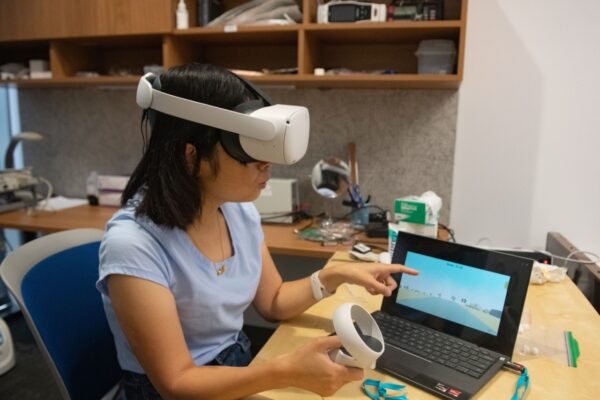Virtual reality (VR) technology has advanced rapidly in recent years, with VR headsets and experiences becoming more immersive and realistic. Now, an exciting new development is the use of VR headsets equipped with electroencephalogram (EEG) sensors to map brain activity during VR experiences. This groundbreaking technology has diverse applications in neuroscience research and medicine.
How VR Headsets Can Track Brain Activity
Traditional EEG brain mapping relies on electrode caps to measure brain waves from outside the skull. This equipment is bulky and cumbersome. Integrating EEG sensors directly into VR headsets provides a more seamless experience for research subjects and patients.

Researchers at the University of Texas at Austin recently customized a commercial VR headset by integrating EEG sensors into the top strap and forehead pad. The headset monitors brain activity via noninvasive electrodes pressed against the skin. This allows tracking of neural responses while users interact with VR environments.
The headset records data on how different areas of the brain react to stimuli encountered in the virtual world. For example, scientists can observe which parts of the brain activate when a user navigates a maze or socializes with virtual avatars.
Potential Applications of VR Brain Mapping
This EEG-equipped VR headset enables new research into brain disorders, enhances VR experiences, and has diverse medical applications.
Studying Brain Disorders
VR headsets with brain activity mapping can help study anxiety, PTSD, phobias, and other mental health conditions. VR exposure therapy is already being used to treat phobias like fear of flying. The EEG sensors provide additional neural feedback on how much someone is distressed during a virtual experience.
Scientists could also study social disorders like autism by analyzing brain waves during simulated social interactions. This technology opens up exciting new avenues in psychology and neuroscience research.
Training and Assessing Pilots
Flight simulators equipped with VR headsets and EEG tracking could train pilots and assess their performance under stressful situations. The brain sensors can reveal how much mental effort pilots are expending and their level of concentration during critical flight maneuvers.
This system could enhance aviation training and safety by monitoring brain activity and preventing overload. VR training with neurofeedback helps pilots learn how to handle stressful flight situations.
Improving VR Experiences
Measuring EEG signals exposes how users neurologically react to different VR environments. Game and experience designers can utilize this brain data to refine their creations.
For example, EEG readouts may show that certain textures, colors or sounds elicit more engagement or relaxation. VR developers can tailor their simulations to user brain responses and maximize enjoyment.
Medical Applications
VR EEG mapping also has promising medical applications beyond mental health treatment. Surgeons could use this technology to map language and motor areas in awake patients’ brains prior to operating near eloquent cortex [2].
Additionally, physicians could assess neurological function in patients with brain injuries, strokes, or neurodegenerative diseases using VR tasks and EEG analysis.
Limitations and Future Research
While promising, VR brain mapping technology still has some limitations. The EEG sensors embedded in current prototypes are somewhat bulky and cause discomfort during prolonged use. As the headsets evolve, the goal is to make EEG integration more seamless.
The other main limitation is validation of EEG data. There are inconsistencies in how different people’s brains activate, even for the same stimuli. More research on diverse sample populations is needed to accurately interpret the EEG signals.
If these limitations can be addressed, VR headsets with compact EEG sensors could become a mainstream research platform. As the technology improves, there are incredible opportunities to revolutionize our understanding of the human brain.
Future studies should explore the extended use of VR EEG mapping on larger sample sizes. There is great potential for commercial VR companies to collaborate with neuroscientists to validate and enhance VR experiences.
The Future of VR Brain Mapping
This novel technology heralds a new era in human brain research. Now scientists can directly observe neurological responses in complex simulated environments with scopes of the imagination never before conceived.
The integration of VR and EEG sensors represents a paradigm shift. In the future, EEG tracking may become a standard feature alongside eye tracking in consumer VR headsets.
Beyond the headset itself, AI algorithms that accurately interpret the volume of EEG data could enable more practical applications. For example, brain-computer interfaces could allow paraplegics to control wheelchairs or prosthetics using just their thoughts.
As virtual reality continues to transform entertainment and social connection, this technology also unlocks amazing new possibilities in neuroscience. VR enriches Human Computer Interaction through a multidimensional sensory experience that more closely mirrors reality.
Measuring the brain dynamics underlying VR experiences will lead to groundbreaking discoveries about perception, emotion, cognition, and consciousness. This knowledge has the potential to reduce neurological disorders and fundamentally transform VR design.
Conclusion
Equipping VR headsets with EEG sensors enables real-time mapping of brain activity during virtual experiences. This innovative technology offers neuroscientists an incredible research tool to explore the inner workings of the mind.
Although the applications are still emerging, VR brain mapping is poised to revolutionize psychology, neurology, user experience design, and our fundamental understanding of ourselves. Unlocking the neurological mysteries of virtual reality promises exciting new possibilities for human flourishing.
Suffice to say, amazing breakthroughs lie ahead as virtual reality reshapes how we study the brain.
